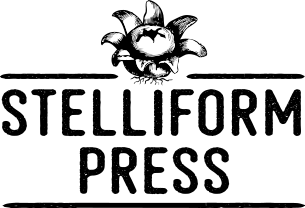Stelliform Press Awards Eligibility 2020
If you’re nominating for the Hugo and Nebula Awards for 2020, consider Stelliform’s first two novellas: DEPART, DEPART! by Sim Kern, and NIGHT ROLL by Michael J. DeLuca. Read more about these books and their reception below.
Depart, Depart! by Sim Kern
Category: Novella
Genre: Horror
Kern’s novella received a starred review from Publisher’s Weekly, which you can read here.
Novella Synopsis
When an unprecedented hurricane devastates the city of Houston, Noah Mishner finds shelter in the Dallas Mavericks’ basketball arena. Though he finds community among other queer refugees, Noah fears his trans and Jewish identities put him at risk with certain “capital-T” Texans. His fears take form when he starts seeing visions of his great-grandfather Abe, who fled Nazi Germany as a boy. As the climate crisis intensifies and conditions in the shelter deteriorate, Abe’s ghost grows more powerful. Ultimately, Noah must decide whether he can trust his ancestor — and whether he’s willing to sacrifice his identity and community in order to survive.
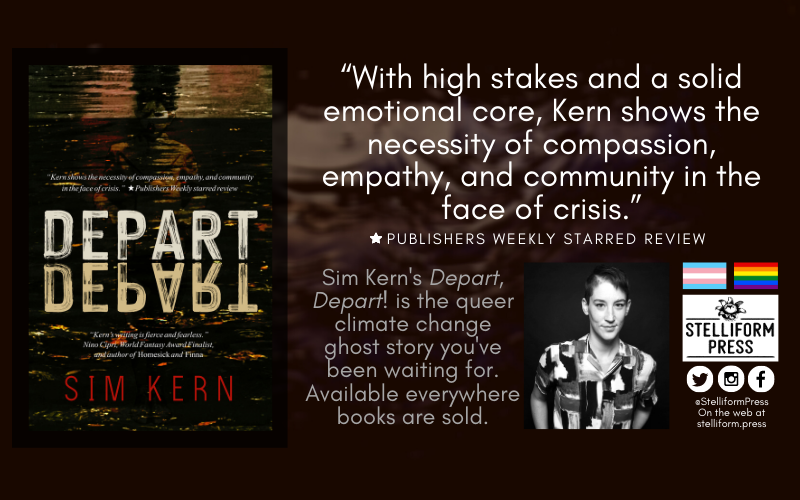
Night Roll by Michael J. DeLuca
Category: Novella
Genre: Fantasy
DeLuca’s novella received a recommended book review from Locus Magazine, which you can read here.
Novella Synopsis
New mother and climate refugee Aileen Dupree has been abandoned by her partner in post-industrial Detroit. Her neighbor, Virgil, comes to her rescue, bringing useful cast-offs and much needed friendship. Virgil is Aileen’s only connection to the outside world, a refuge for an insomniac newcomer who is overwhelmed by the turn her life has taken. But then Virgil borrows Aileen’s prized possession — a chrome and leather, royal blue fourteen-speed bike — and disappears. Aileen doesn’t know if Virgil’s disappearance is an accident or another abandonment.
When she ventures out to look for answers, Aileen hears strange stories of the Elf, a timeless being that has always fought the colonizers and capitalists of Detroit, and now leads the Night Roll on a frantic race through the city’s disintegrating streets. It is up to Aileen to bring Virgil back to his friends and family. But what can the Elf teach her about her new life? And what must she pay for that knowledge?
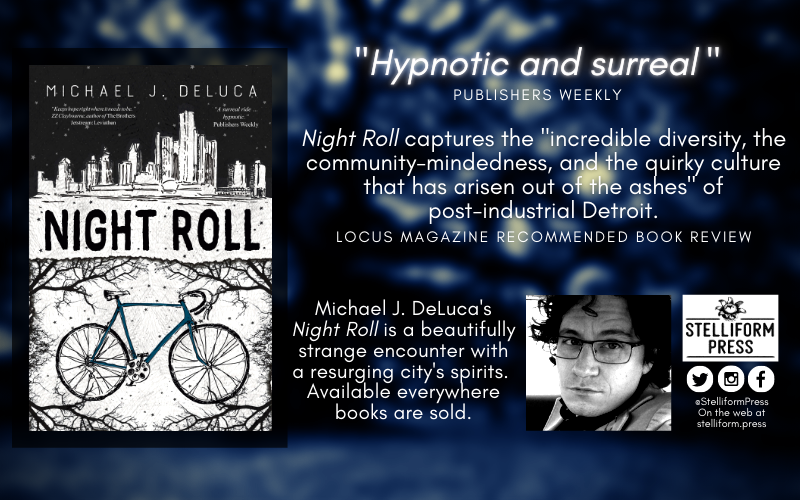
Both novellas are available for purchase here, or wherever books are sold.
Stelliform’s Faves, Part 3
This post is the last in our “Faves” series, in which the Stelliform team discusses some of their most beloved eco- and related fictions. In Part 1, Stelliform Publisher and Editor-in-Chief, Selena Middleton wrote about her love for Hopkinson’s Midnight Robber, Cherie Dimaline’s Empire of Wild, and others. In Part 2, Kristen Shaw and Rae Stoltenkamp wrote about Brooke Bolander’s The Only Harmless Great Thing (which we also reviewed here), Octavia Butler’s The Parable of the Sower, and more.
In this series finale, our Publishing Consultant and occasional proofreader Jacqueline Langille writes about her favourite eco-focused books and films, and what she has learned from the prevalent motif of the unforgiving environment in science fiction.
The Unforgiving Environment
by Jacqueline Langille
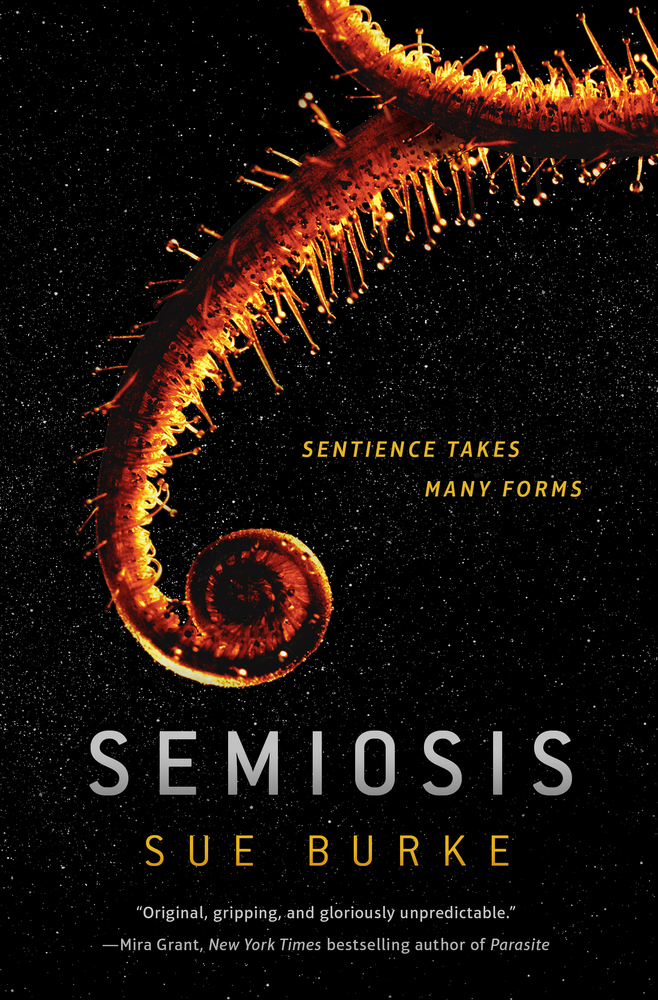
While eco-fiction may be labelled a super-genre by some critics, I have mainly read such stories in the realm of science fiction, from Dune by Frank Herbert (1965) to Oryx and Crake by Margaret Atwood (2003). My most recent “favorite book” happens to be eco-sci-fi: Semiosis by Sue Burke (2018). In that novel, which I’ve recommended to everyone I’ve ever spoken to since its publication, the human characters have fled to the stars in search of a new environment to colonize after ecological disasters on Earth. I love this story because no matter how well the humans, in their hubris, prepare to take over a new world, it’s when they build a strong relationship with the local plant life that they are not overcome by this unforgiving environment. They find constant jeopardy in any relation they try to establish with their food sources and their competitors on the planet Pax, and they must rely on other sentient and mobile beings to achieve any sort of longevity, never mind finding peace.
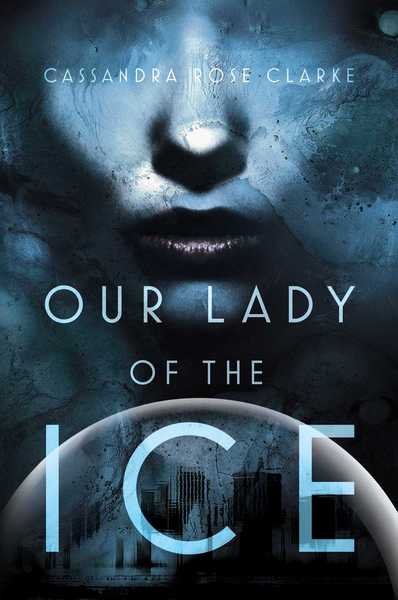
My other favourite eco-fiction examples also feature unforgiving environments, albeit more urban with fewer animal elements, such as the silo habitat in Wool by Hugh Howey (2011) or a decaying dome city in Antarctica in Our Lady of the Ice by Cassandra Rose Clarke (2015). Beyond urban or ice, a liquid world represents one of the most inhospitable habitats for humans, air-breathers and not-great-floaters that we are, and this unforgiving environment is explored with relish in the movie Waterworld (1995). Kevin Costner’s loner tries to survive and adapt, yet his life gains meaning and purpose only when he builds relationships with other humans and shares his skills for living in and on the water. The ecology of Waterworld, its focus on the relationships between human animals and their environment, with some humans continuing to be destructive of course, is why I love that movie (even though its running time is much too long at 135 minutes).
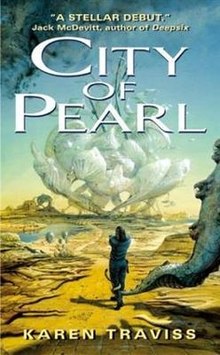
Modern action movies and myth-makers of old tend to focus on great deeds, but the books I enjoy most focus on the relationships. In the best books, I feel like an ecologist discovering how all these relationships work, between characters, within their environment, among the most alien of cultures and planets that human authors can imagine. As I dove into the setting of City of Pearl by Karen Traviss (2004), I knew I had found another unforgiving environment to love. While the human colonizers seem to be making a go of it on a new planet, the hostile elements surface in the plot when they realize they are not alone on this world (more human hubris). And they are not in charge (eek! did I give too much away?). Writing about this book makes me want to order the entire series and live inside that place until next spring.
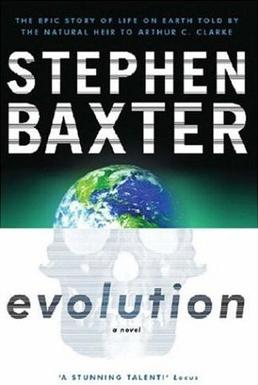
Evolution by Stephen Baxter (2003), another book I’ve recommended to almost everyone I know, may not fit into the more basic definition of eco-fiction, but the entire planet is our ecosystem, and the history of the planet covers so much more than human relationships with that environment, so it definitely fits. A collection of vignettes about mammals and sentient creatures surviving in various unforgiving Earth environments, this book covers +500 million years (trust me, it’s not confusing when you’re immersed in it). Fiction can help me understand concepts that I know intellectually but that I really don’t take into my core. The previous examples of eco-fiction, along with James Howard Kunstler’s The Long Emergency (2006) helped me understand that humanity’s one chance to survive, let alone thrive, exists in our capacity to build resilient relationships with each other and with our environment. From Evolution, I received an understanding that the before-humans phase of this planet lasted many millions of years, and the after-humans phase will last many hundreds of millions of years too. And that’s okay. If we fail to acknowledge how crucial our relationship with our natural world is and we fail to thrive in this unforgiving environment, it’s tragic and terrible to ponder for future generations of humans, but it’s also okay. It’s only hubris.
Revisit the Series:
Check out Stelliform’s favourite books:
The New Wilderness by Diane Cook: A Discussion Review
We had so much fun doing a conversational review of Stephen Graham Jones’ The Only Good Indians that Selena Middleton and Kristen Shaw are tackling Diane Cook’s The New Wilderness, a book that’s been called “the environmental novel of our times.” Cook’s debut is about a young family that takes part in an experiment in order to save their ailing daughter: can humans live in the wilderness without destroying it? The book was published by Harper on August 11, 2020 and has since been shortlisted for the Booker Prize and picked up by Warner for a TV adaptation. This is not a book you want to miss. In this review, Selena and Kristen tackle some of the book’s big ideas.
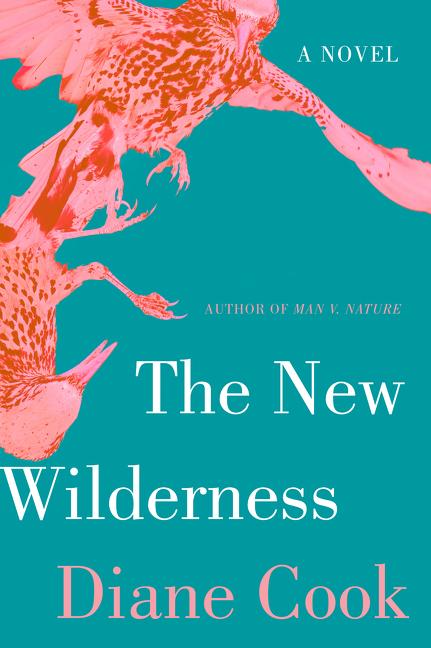
Selena Middleton: The thing that makes Diane Cook’s The New Wilderness compelling for me is how it’s dismantling any romanticization of nature that still exists in the West. Of course this dismantling has been going on for some time, but Cook’s Wilderness feels like a fatal blow. From the beginning, she shows us how nature, or wilderness, is not an escape but a force that shapes us as we shape it — and not always in positive ways. At the same time though, the book isn’t entirely cynical about our place amongst non-human beings.
Kristen Shaw: Yes, I really liked that the sense of “nature” here is deromanticized and she challenges the ways humans idealize nature and fetishize the nonhuman. So often nature is presented as the site of a utopian escape from the horrors of urbanity and the human. “Escaping to nature” is seen as a way to escape the alienation of urbanized life. But in The New Wilderness both popular concepts of nature and the dichotomy between “nature” and “civilization” are broken down.
What exactly is a “Wilderness?”
SM: Before we get into that I thought it might be useful to break down some environmental terminology. Diane Cook uses the word “wilderness” in the title of the book and as the story progresses we see that there are a few different definitions of “wilderness” at work — many different uncontrolled or uncontrollable environments, both external and internal. Most words that try to define a space outside of the human are plagued with this same slipperiness. For example, I try not to use the word “nature” because it can mean the environment, but not including the humans that live in or around it. And a space that doesn’t include humans just doesn’t exist. Like Diane Cook’s Wilderness State, even so-called “nature” is influenced and controlled by humans at every level. When I see that word in a text I have to ask what does the author mean by using the words “nature” or “natural”. Raymond Williams calls “nature” the most complex word in the [English] language because of the ambiguities around it. Especially now when most of the world’s environments are altered by humans in some way, the word “nature” can be misleading. And the word “wilderness” is the same. Does wilderness even exist anymore? Did it ever?
I’m reminded of William Cronon’s writing on wilderness. He points out that the idea of wilderness is a “cultural invention.” For example, today many seek out wilderness as some kind of escape from their everyday experience, but a few hundred years ago the word wilderness had different connotations. Cronon writes that “as late as the eighteenth century … the emotion one was most likely to feel in [the] presence [of wilderness] was “bewilderment” or terror” (William Cronon, The Trouble with Wilderness). If one went into the wilderness it wasn’t for rest and relaxation but a reckoning, as one might face a bear or a mountain lion (because that’s probably what would have happened — and Agnes’ terror of cougars waiting in ambush reminds us of that).
KS: This gets at something I felt throughout the novel — I felt a sense of the uncanny emerging when characters are confronted with nature in a way that challenges the way they typically think about it. When Bea is thinking about how nature is idealized, she recalls that “there used to be a cultural belief, in an era before she was born, that having close ties to nature made one a better person. And when they first arrived in the Wilderness, they imagined living there might make them more sympathetic, better, more attuned people. But they came to understand there’d been a great misunderstanding about what better meant. It’s possible it simply meant better at being human, and left the definition of the word human up for interpretation. It might have only meant better at surviving, anywhere, by any means.” The characterization of the environment in the novel subverts a lot of environmentalist narratives that represent nature as a utopian, prelapsarian realm (which is also, ironically, often presented as in need of saving by the same human forces that have systematically destroyed it). Just like the environment is not a bound thing but rather exceeds efforts to control it, similarly, the environment cannot be reduced to the human concepts projected onto it. I felt this sense of disconnect, perhaps akin to what Cronon calls that “bewilderment” and “terror,” emerging at different points in the novel. The characters recognize that they are somewhere that they never expected to be, in a setting that doesn’t fit the narratives they constructed about it. The novel begins with an effort to return to a kind of Eden, but the characters soon realize that Eden never existed and is a complete fiction.
The New Wilderness: A Brutal Eden
SM: Cook’s wilderness is certainly no Eden, at least not how that place is commonly understood. So what does she mean by her title “The New Wilderness”? From the first scene where we see Bea give birth to her stillborn daughter and bury her in a shallow grave that she knows will be raided by coyotes as soon as she steps away from it, the reader understands wilderness not as a site of human creation and flourishing, but struggle and resilience. Later on we come to understand this wilderness as a highly managed space — one that is not only continually physically tended to, but also surveilled. While Cook’s “Wilderness State” feels at first far removed from urban life, the reader gradually understands that the State is watched by not only the Rangers but also people in the city, who judge the State’s inhabitants pretty harshly.
KS: This is a great point, and I agree Cook achieves this by subverting the binaries between non-human and human, and nature and urban. Initially we have the City on one side, represented as a bleak, dark place. The Wilderness is seen to offer some escape from the city’s sense of alienation and surveillance. Yet, by the end of the novel, the idea that the City is separate from the Wilderness is not so cut-and-dry. Bea even notes that “living in the Wilderness wasn’t all that different than living in the City” because they both teach different types of survival. Both are surveilled and controlled by human forces, just in different ways. So the idea of stepping away from civilization to achieve freedom crumbles. All these established categories – human vs. nonhuman, nature vs. city – become destabilized. I think if there is a dystopian element to the novel it lies in this looming sense of uncertainty as all these previously stable concepts come untethered.
SM: I like this word “untethered” to describe how the cultural ideas we make assumptions about are brought under the harsh light of life in the Wilderness State. Even family relationships. Mother-daughter relationships. Through Bea and Agnes’ relationship we begin to remake our own ideas of place after becoming destabilized or untethered. Because the main characters are a mother and daughter pair, the reader settles into a child-like role — first observing the way Bea responds to her life in the Wilderness State, especially as it pertains to her mother role, the way she teaches her daughter about life there (even when those teachings are harsh, mirroring the kind of brutal indifference of the land to human life) and then we get a more direct experience of growing up in the wilderness, being shaped by it (and also by an often maladapted mother) through Agnes. But Agnes was born in the city and has an almost pre-natal experience of the urban environment, to which she is forced to return in the end. And I think that has shaped her too, because of her direct experience of ill health in the city environment and because of the way Bea brings the city with her into the wilderness. Even though Agnes gains her health and grows and develops as a person in the wilderness, she is still shaped by the city so she is able to adapt in the end to going back there.
KS: Yes, Agnes seems like a liminal character who is neither of the City nor the Wilderness. Bea feels tethered to the City in a way that Agnes doesn’t, but she isn’t entirely distinct from it either. I think Agnes represents a kind of transitional generation. One that is not defined by the opposition between the urban and the natural but by the processes of uncertainty and adaptation that occur as these ideas are challenged. She doesn’t have the same commitment to ideas of the Wilderness or the City that Bea’s generation does. I love the last scene in the book when Agnes uses the paint chips to create an image of the Wilderness on the wall for herself and Fern. For me it represents how Agnes bridges this divide between the two worlds. There is something lost in translation, obviously, but the act represents how she is split between these two realms, trying to negotiate her place in them using the survival techniques she’s developed from both. Unlike Agnes, though, Fern seems to represent a totally new kind of human that relates to the nonhuman in a new way.
New Humans in Exile
SM: Jumping off this idea of the creation of a new kind of human, I want to return to this idea of Eden — which is one way to interpret Cook’s Wilderness State — and what it means to live in and then ultimately leave this place as all members of the community do. Eden is a utopia—a good place that does not exist except for in the minds of the members of the community, as a cultural construct that is simultaneously memory and aspiration (or past and future). And this is at least part of the problem with mainstream Western conceptions of nature, and even some forms of environmentalism; it doesn’t engage with the here and now. It ignores the real and immediate relationships of humans as animals who exist within an ecosystem. Furthermore, when we escape into wilderness spaces we may think that we’re escaping the problems that human society has created — problems which can be intensified in urban spaces because that’s where human population is densest, problems which are exacerbated by the pressures of capitalism and, increasingly, ecological collapse — but we really bring those problems with us. I think we see that in Bea’s character and the often ruthless way she behaves in the Wilderness State. But it would be a mistake to blame the City exclusively for that behaviour, I think. It’s really complex. That the Wilderness State makes Bea’s life both better and worse aligns with the ways that the pressures of life in the City represent both convenience, sociality, and tremendous physical and emotional stress of that environment. But maybe most of all Bea’s behaviour is tied to the fact that she lives in neither place — not Wilderness nor City. Instead, she lives in some idealized or romanticized version of both places. Even though her body goes through the motions of surviving in both wilderness and city, her spirit — her emotional and social connections — are elsewhere.
KS: Interesting point. I think that’s a great observation and is linked to Bea’s choices to leave the Wilderness and then come back later. Neither place fulfills what she wants it to do for her, and this seems to be represented by what, to Agnes, looks like indecision and an inability to commit.
SM: I’ve skirted around it a bit, but the idea of leaving Eden and having to live essentially in a state of exile is both Bea and Agnes’s reality. They handle that reality differently according to their level of ecological connectedness; but Cook gives us some hope to cling to at the end of the novel in the appearance of Fern’s character. Fern is a young girl Agnes meets when she’s on the run in the wilderness, when she already knows that it’s only a matter of time before she will be exiled from the space she considers her home. I was struck by Fern’s entrance into the story — how similar it was to the beginning of the novel when Bea gives birth to a stillborn daughter on the hillside above the community camp. Agnes takes Fern into her care after finding her clinging to her dead mother and infant sibling. Agnes has felt the loss of her sister throughout the book, and in Fern it’s as though she finally regains that relationship. The scene is also reinforcing a recurring theme in the book — this close relationship between life and death. But Fern is on the side of life and hers is a life of flexible adaptation and wonder at every environment, even when they leave the wilderness and must live in the city. I loved this quote describing how Fern sees the city near the end of the novel:
Here in the City, she takes all of this concrete, bustle, decay in with interest. She’s inquisitive as she wanders around, as though it is just another wilderness to explore. Another part of the map we had yet to unfold. A thing to become part of. She calls it her New Wilderness…
Maybe just as Cook has mapped out a “new wilderness,” she has also pointing to Fern as a new kind of human, showing us a way forward as the ecosystems our bodies have known for millennia fail and we have to find new ways to live. That way forward looks like open-eyed amazement at all the world has to offer, acknowledgement that every environment is an ecosystem to be a part of. In a way, Fern sees the entire world — both the urban and the wilderness — as a utopia, but not in a fetishizing or romanticizing way. Maybe Cook is asking us to be children again, to re-raise and re-educate ourselves for this new world.
Final Thoughts: Important Ideas with Some Limitations
KS: That’s a lovely thought and I can definitely read that into the novel. If we look at the novel in that way, then, it’s surprising how much it focuses on the settler experience. We both found it troubling that there was no explicit acknowledgement of Indigenous people or inclusion of Indigenous characters. This should have been addressed, in my opinion, even if the exclusion was intentional.
SM: Yes, even if Cook didn’t intend it this way — and there does seem to be some effort from her to consider another perspective in the land acknowledgement at the end of the book — that consideration doesn’t show up in the narrative itself. I pointed to Fern as a character that maybe Cook is upholding as an example of appropriate relations with the environment and this is the only character for whom there is evidence that she is possibly a person of colour. When Agnes first meets Fern, Fern responds to her in Spanish. This fact, and the rumour that Agnes heard that people are flooding into the Wilderness State, for me recalled the climate refugees we’re seeing moving north from Guatemala and other parts of Central and South America. That the community in which Bea and Agnes were a part in the Wilderness State (a community that seems to be comprised of white urbanites) collapses and Agnes is left with only Fern as a companion could be Cook’s way of signalling the future of human community — a multi-racial, multi-lingual, multi-cultural conglomeration with a flexible understanding of human-environment relations.
But this feels tacked on to the narrative and even Cook’s acknowledgement at the end of the book seems an afterthought that doesn’t name specific people, only entire communities. It is troubling and I wonder what this book would have looked like if Cook had brought Fern in sooner or had more interaction between the original community and the refugees coming into the Wilderness State. Instead of positioning them as rivals for that space. That said, maybe this book is meeting (white) people where most of them are. Given that so few Western countries are making moves toward the kind of drastic societal changes that need to be made in order to mitigate the worst effects of climate change, a book that disrupts conceptions of “nature” and nudges a reader toward a more relational perspective certainly has its place. The New Wilderness is a compelling read, and I found myself thinking about it for a long time after I finished it, but ultimately it is only part of a much wider conversation that needs to include Black, Indigenous, and people of colour from beginning to end.
If you enjoyed this review, be sure to check out our conversation about Stephen Graham Jones’ The Only Good Indians. Did you love Diane Cook’s The New Wilderness? Drop a comment to let us know.
Stelliform Year 1 Reviews
Our first two books are now launched and are making their ways around the world to readers and reviewers alike. Starting a publishing endeavour during a pandemic has been challenging — certainly we would have sold more copies if we’d been able to go to the cons we’d planned to go to, or see anyone at all in person — but we’ve been delighted at the enthusiasm we’ve seen from readers and reviewers online, and from those of you who came to our online launches or engaged with us on social media. It’s felt like the kind of community-building we’d hoped for. The kind that is imperative now and in the future.
In honour of this milestone, let’s take a moment to revisit the hype! Both Stelliform 2020 titles have gotten some fantastic reviews. We’re thrilled that people are paying attention to books coming from a brand new press.
Sim Kern’s Depart, Depart!
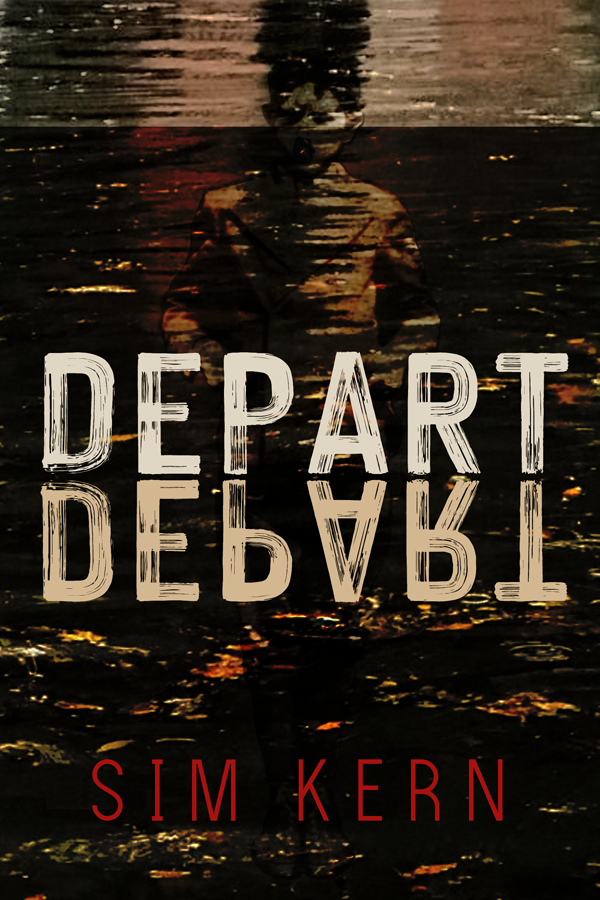
Kern’s novella is our first book to receive a starred review from Publishers Weekly. PW called the book a “tense, entrancing debut” and the review highlights the importance of community in this short horror. “With high stakes and a solid emotional core, and a perfect balance of speculation and an all-too-real vision of climate apocalypse, Kern shows the necessity of compassion, empathy, and community in the face of crisis.”
Kern also got a shout-out from the World Fantasy finalist and author of Finna and Homesick, Nino Cipri. Cipri wrote that “Kern’s writing is fierce and fearless” and the novella is “for all of us trapped in unravelling situations, facing the seemingly intractable binary of being safe and alone, or vulnerable but together.”
Another review we loved came from Em Rowntree at The Geekiary. Rowntree focuses on an aspect of the novella that is so important: that the book both calls for social connection and is an agent for it. Rowntree writes, “It [felt] like a gift to read a scene where a trans character gets to meet his family who’ve passed away, and they offer him love. It soothed a little of the hurt in me that’s there for so many people who aren’t cisgender.” Indeed, Kern’s book is a rare healing horror novella.
Check out more reviews and blurbs here and, of course, on Goodreads.
Michael J. DeLuca’s Night Roll
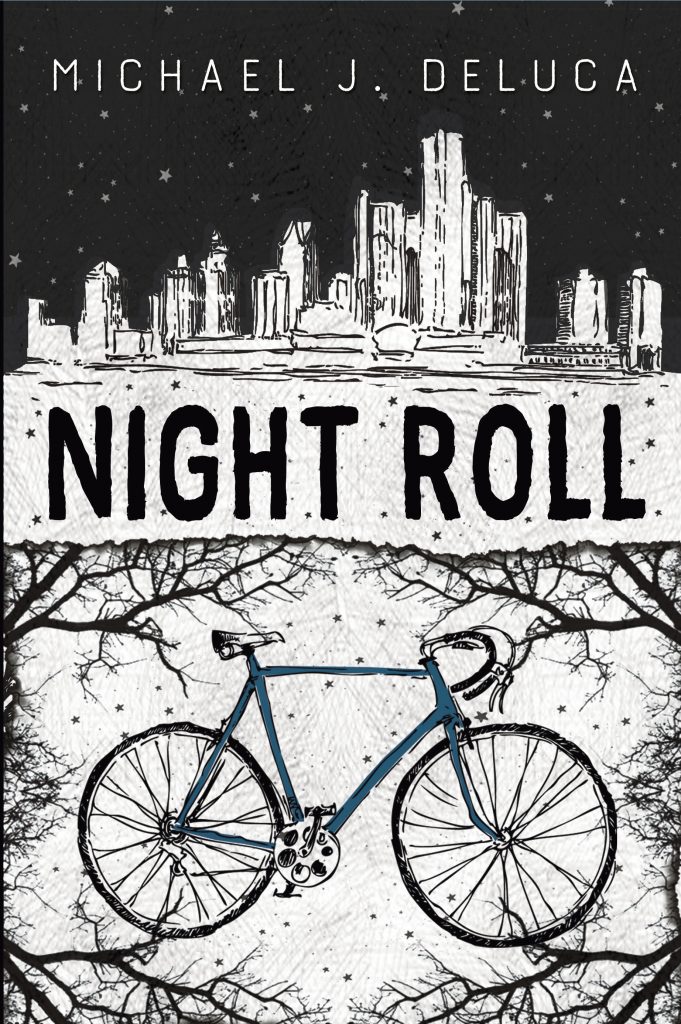
This week Michael J. DeLuca’s Night Roll received a wonderful review from Locus Magazine’s Karen Burnham. Burnham, who knows Detroit well, notes that Night Roll is the “the most Detroit story I have read since Alexander Irvine’s The Narrows.” Focusing on the way the novella brings forward the city’s unique setting and character elements, Burnham writes, “Night Roll brings home a lot of things that are wonderful about that city: the incredible diversity, the community-mindedness, and the quirky culture that has arisen out of the ashes of the post-industrial city. … I’d recommend this book for anyone who’s ever thought “Detroit? Who would ever want to live in that wasteland?” Burnham highlights other elements of Night Roll that you don’t want to miss, so check out the full review here.
Publishers Weekly’s review of DeLuca’s novella notes the intermingling of style and structure when they write that “the odd, lyrical story meanders, propelled only by the force of Aileen’s determination to take control of her life … The result is a hypnotic near-future novella that will captivate literary and genre readers alike.” The full review, highlighting the novella’s fairy tale and historical connections, is here.
DeLuca received some truly fantastic blurbs as well, such as this from the World Fantasy and Campbell-nominated author Christopher Brown. Brown wrote that “Michael [J.] DeLuca’s NIGHT ROLL is one of the most vivid and captivating works of near future fiction I have read in a long time … DeLuca’s gifts for drawing out the pockets of wild nature resurgent within the concrete canyons of the city are enough to hold my attention throughout, but the fresh authenticity of voice and vulnerable but committed charisma of his characters are what keep you turning the pages of this compelling novella.”
More praise of the novella from Detroit’s Z.Z. Claybourne and Sonia Sulaiman at The Future Fire are linked here.
Leave Reviews and Stay Tuned
Have you read Stelliform’s first novellas? We’d love to hear what you thought here, on social media, or any book review site. In the meantime, we’ve announced two books for Stelliform Year 2 and we’re excited to share more environmentally-engaged fiction with you.
Announcement: Stelliform Acquires Octavia Cade’s The Impossible Resurrection of Grief
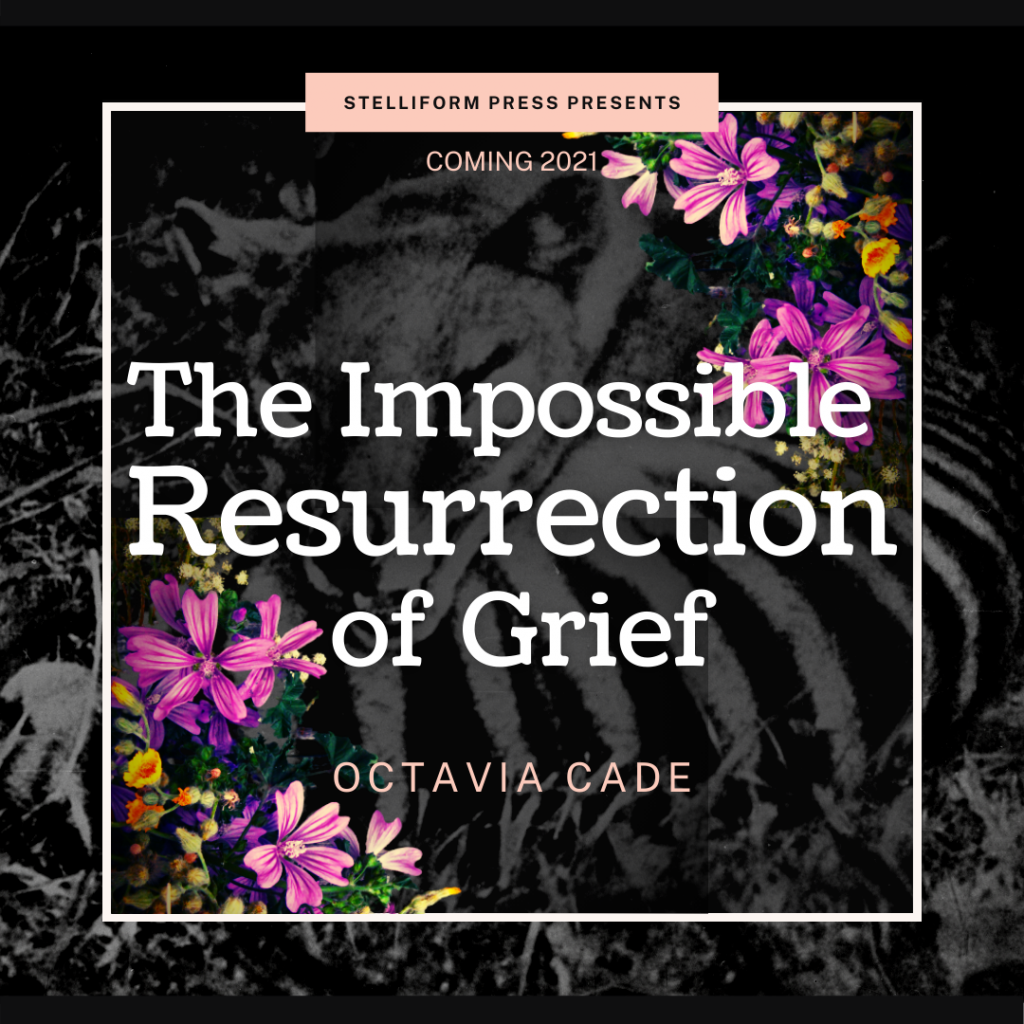
We’re delighted to announce Stelliform Press’ acquisition of a novella by Octavia Cade, The Impossible Resurrection of Grief. Octavia Cade is a New Zealand writer with a PhD in science communication. She attended Clarion West 2016, has won three Sir Julius Vogel awards for speculative fiction, and is a Bram Stoker nominee. She was the 2020 writer in residence at Massey University, where she wrote this novella. Cade’s previous publications include stories in Asimov’s, Strange Horizons, Apex Magazine, and Clarkesworld. Her first novel, The Stone Wētā, was published this year by Paper Road Press.
This science fiction novella has a complex and troubling emotional core. The third novella from Stelliform Press, The Impossible Resurrection of Grief features a world in which climate change disruptions fray the emotional threads of humanity and raise questions about the many extinctions in which humans have played a part.
Read more about The Impossible Resurrection of Grief below:
With the collapse of ecosystems and the extinction of species comes the Grief: an unstoppable melancholia that ends in suicide. When Ruby’s friend, mourning the loss of the Great Barrier Reef, succumbs to the Grief, the letters she leaves behind reveal the hidden world of the resurrected dead. The Tasmanian tiger, brought back from extinction in an isolated facility, is only the first… but rebirth is not always biological, and it comes with a price. As a scientist, Ruby resists the Grief by focusing her research on resilient jellyfish, but she can’t avoid choosing which side she’s on. How can she fight against the dead and the forces behind them when doing so risks her home, her life, and the entire biosphere?
Be sure to sign up for our newsletter, and follow us on Twitter, Facebook, and Instagram to get the latest news about this release, coming in 2021.
